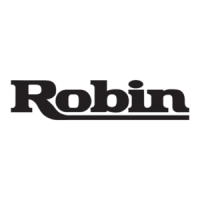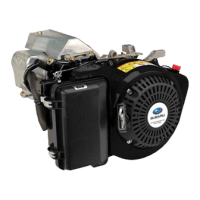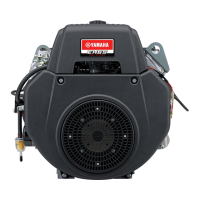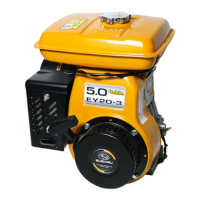Do you have a question about the Robin America EX27 and is the answer not in the manual?
Defines engine output at full throttle after break-in.
Specifies optimal output for engine life and fuel efficiency.
Describes torque at the output shaft at maximum output.
Graphical representation of engine output and torque across RPM range.
Highlights engine noise reduction and sound quality.
Describes reliable starting and reduced kick-back.
Details ease of maintenance due to common parts and simple procedures.
Covers advanced design features for reliability and durability.
Focuses on high power output and low fuel consumption.
Details the construction of the cylinder and crankcase.
Details the components and design of the connecting rod and piston.
Details the transistor controlled magneto ignition system.
Describes the horizontal draft carburetor and its setting.
Explains the automatic decompression system for easier starting.
Provides a cross-sectional view of the engine across the shaft.
Provides guidelines for safe and effective engine disassembly.
Lists specific tools required for disassembly and reassembly.
Step-by-step instructions for disassembling the engine.
General guidelines and steps for engine reassembly.
Details API classifications for suitable engine oil grades.
Explains SAE viscosity grades based on ambient temperature.
Provides procedures for checking and changing engine oil.
Describes the T.I.C. type breakerless magneto ignition system.
Outlines procedures for checking magneto defects.
Explains the T.I.C. pointless ignition system for specific models.
Details the ignition system specifically for the EX27 model.
Wiring diagram for models without an electric starter.
Wiring diagram for models with electric starter (EX17, 21).
Wiring diagram for the EX27 model with electric starter.
Wiring diagram illustrating the oil sensor and control unit connection.
Provides specifications for electric starters on EX17, 21, and EX27 models.
Explains the operating principles of the electric starter system.
Details component parts of the electric starter for EX17 and EX21.
Illustrates component parts of the electric starter for Model EX27.
Lists specifications for the oil sensor type, resistance, and temperature.
Explains the oil sensor's composition, operation, and float mechanism.
Details the functions and construction of the decompression system.
Provides guidance on inspecting the release lever for smooth operation.
Lists specifications for main jet, pilot jet, and pilot screw for different models.
Explains the float, pilot, main, and choke systems of the carburetor.
Details procedures for disassembling and reassembling the carburetor.
Provides instructions and required tools for recoil starter.
Step-by-step guide for disassembling the recoil starter.
Step-by-step guide for reassembling the recoil starter.
Procedures for checking the recoil starter function after reassembly.
Focuses on engine positioning and coupling with equipment.
Covers fuel tank height, fuel pump use, and hose routing.
Discusses methods for transmitting power to driven equipment.
Covers common engine starting difficulties and their causes.
Lists causes and remedies for poor engine output.
Identifies causes and remedies for engine overheating.
Addresses causes and solutions for excessive engine oil consumption.
Troubleshooting flowchart for electric starter issues when the engine fails to start.
Evaluates battery voltage and specific gravity for proper function.
Checks ignition and fuel systems when starter and engine run but don't start.
Lists standard dimensions and wear limits for engine parts.
Provides specific torque values for various engine bolts and nuts.
Details daily maintenance tasks and their reasons.
Outlines maintenance tasks for every 100 hours or 10 days.
Details annual maintenance procedures, including overhaul.
Provides instructions for proper engine storage procedures.
| Brand | Robin America |
|---|---|
| Model | EX27 |
| Category | Engine |
| Language | English |











